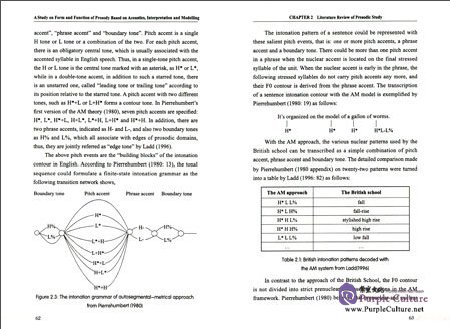CHAPTER 1 Introduction
1.1 Background of prosodic study of natural languages
1.1.1 Function of prosody
1.1.2 Form of prosody
1.2 Mandarin prosody: issues and previous approaches
1.2.1 Introduction of Mandarin
1.2.2 Earlier studies on the interaction between
tone and intonation
1.2.3 Previous studies on rhythmic accent
1.2.4 Recent studies: from data to modelling
1.3 Objective of the present study
1.3.1 The data of the study
1.3.2 A plausible mapping between form and function
CHAPTER 2 Literature Review of Prosodic Study
2.1 Introduction
2.2 The British School
2.3 The Dutch School
2.4 The American School
2.4.1 The level approach
2.4.2 The Autosegmental-metrical approach
2.4.3 The ToBI labeling system
2.4.4 Pan-Mandarin system
2.5 Summary
CHAPTER 3 Speech Corpora and Labeling Methodology
3.1 Introduction
3. 1. 1 Daily-conversation corpus
3.1.2 Read-speech corpus
3.2 Data selection and labeling
3.3 Summary
CHAPTER 4 Three Functional Components
of Mandarin Prosody
4.1 Introduction
4.2 Lexical tone
4.2.1 The functional role of lexical tone
4.2.2 The paradigmatic annotation of lexical tone
4.2.3 The autosegmental property of tone
4.2.4 The phonological representation of tone:
level vs. contour systems
4.2.5 Tone sandhi in context
4.3 Rhythmic accent
4.3.1 Accentual hierarchy
4.3.2 The prosodic structure of Mandarin speech
4.3.3 Prosodic grouping and tone-sandhi domain
4.4 Intonation
4.4.1 The melodic events of Mandarin speech prosody
4.5 Summary
CHAPTER 5 Analysis by Synthesis of Mandarin Prosody
5.1 Introduction
5.2 Evaluating the predicted data with Prozed
5.3 Discussion
5.4 Summary
CHAPTER 6 Conclusion
Bibliography

"phrase accent" and "boundary tone". Pitch accent is a singleH tone or L tone or a combination of the two. For each pitch accent,there is an obligatory central tone, which is usually associated with theaccented syllable in English speech. Thus, in a single-tone pitch accent,the H or L tone is the central tone marked with an asterisk, as H* or L*,while in a double-tone accent, in addition to such a starred tone, thereis an unstarred one, called "leading tone or trailing tone" according toits position relative to the starred tone. A pitch accent with two differenttones, such as H*+L or L+H* forms a contour tone. In Pierrehumbert'sfirst version of the AM theory (1980), seven pitch accents are specified:H*, L*, H*+L, H+L*, L*+H, L+H* and H*+H. In addition, there aretwo phrase accents, indicated as H- and L-, and also two boundary tonesas H% and L%, which all associate with edges of prosodic domains,thus, they are jointly referred as "edge tone" by Ladd (1996).
The above pitch events are the "building blocks" of the intonationcontour in English. According to Pierrehumbert (1980: 13), the tonalsequence could formulate a finite-state intonation grammar as thefollowing transition network shows.
Boundary tone Pitch accent Phrase accent Boundary tone.